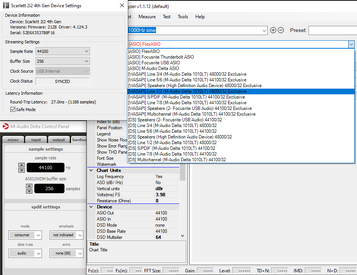I got lost in your reports. Nevertheless the logs suggest the LT1010 exclusive access (i.e. directly to the driver) supports only 44.1kHz. That would hint at the locked rate I talked about - the windows driver user guide does show the checkbox for locking the rate - but the setup screenshots I asked about were never posted here...
What setup screen shots are referring to that I haven't posted? I just supplied what you initially requested in
post 16. I just ran a calibration in REW at 88 and 96kHz using the Delta ASIO drivers. Regardless of whether or not the 1010LT driver supports exclusive mode only at 44.1k what I just posted with the log files was for all the latest testing at 44.1k to eliminate any higher rate issues so it's not related to exclusive mode use. As I said, I've always ensured that exclusive mode was set. It's also unrelated to buffer size (I've tried every possible range setting). Unlikely related to clock issues since I tested the combination of motherboard output to 1010LT input. Two clocks, works perfectly. I posted that screen capture earlier.
Process of elimination. I've tried essentially every possible combination I can figure out. Changing a single item at a time.
To repeat, when using the FlexASIO (first suggested by John) the WDM-KS driver never failed to run in REW, though the Wasapi did. WDM-KS is described by Microsoft as kernel mode and my understanding of that is that both Wasapi exclusive and WDM-KS are essentially the same only using different coding to implement. Wasapi may take a different path to the card, that's my take on it. The exclusive setting bypasses most of the Windows code.
This is the 96kHz calibration in REW. I doubt it's not in exclusive mode through the Delta driver, but since this is for the same I/O device and the Delta control panel does not provide anything specific to exclusive or not it may not show anything helpful. The REW generator did have the check box for Lock Frequency to RTA FFT set, though it may be only a requirement for most accurate THD vs Level. Still details in REW that I haven't dug into thoroughly.
I still suspect that it has to do with USB. That's the single factor significantly different in all combinations.














